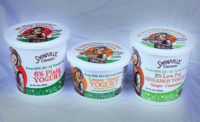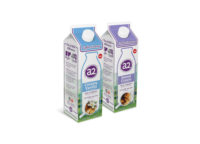
A review of new yogurts introduced in the market over the past two years from the Innova Market Insights database shows examples of products made from goat, sheep, and A2/A2 milks in North America. The 23 new products found in the search represent a small fraction of the 1,000 new yogurt launches, but they are niche products that only appeal to certain consumers. Most consumers purchase these products for nutrition and health reasons, but there is science behind these specialty milk sources.
What is A2/A2?
The first A2 milk brand on the market, a2 Milk Co., was founded in New Zealand in 2000, which has the rights to use the A2 name. The a2 Milk Co. has bred its cows to produce only the A2 beta -casein protein. All other brands of A2 milk products have to use A2/A2 on their product label.
If you haven’t read about A2 milk, let’s do a quick review of the science. A2 milk is a type of milk that lacks the A1 form of the milk protein, beta-casein. Beta-casein makes up about 30% of the protein in cow’s milk. Cow’s milk naturally contains both A1 and A2 beta caseins. A1 and A2 forms of beta-casein are genetic variants of beta-casein that differ by one amino acid substitution at the 67th residue of the 209-amino acid beta casein protein chain. The sole difference between A1 and A2 takes place at amino acid 67, where histidine is substituted for proline.
Proline forms a tight bond with amino acids on either side of it in the A2 variant, but histidine doesn’t do that in the A1 variant. Rather, in our digestive tract, because of the weakness of the peptide bonds with histidine, a peptide consisting of seven amino acids breaks off. This peptide is a beta-casomorphin (BCM) called BCM-7, and is also an opioid peptide.
It has been demonstrated in a clinical study that consumption of milk containing A1 beta casein was associated with greater gastrointestinal symptoms such as longer gastrointestinal transit times, softer stools and diarrhea (Nutritional Journal 2016;16:35). Often the symptoms present themselves like lactose intolerance, but testing is best to make sure.
It is possible to test for BCM-7 sensitivity as well as protein and other food sensitivities. The structure of A2 protein is more comparable to that found in human milk, goat, sheep, and buffalo milk. Yogurts made with A2/A2 milk are relatively new to the market but offer A2/A2 milk consumers a fermented product option to better meet their digestive needs.
Goat and sheep milks
One of the reasons that consumers turn to goat and/or sheep milk is because they may be allergic to cow’s milk or feel more digestibility issues when they drink cow’s milk. Typically, allergies or sensitivities would be related to a specific protein or proteins like the A1 protein. Yet, some consumers find they can tolerate goat or sheep milk better. Besides the A2 protein difference, the composition of goat and sheep milk is different from cow’s milk. Goat and sheep milk have more fat, with 4.5% and 7.5% respectively, compared to 3.9% in cow’s milk. Goat and sheep milk also have more total protein (with more casein and similar whey protein levels), at 3.6% and 5.6% protein respectively, compared to 3.2% in cow’s milk.
These higher values correspond to a higher total solids content for both goat and sheep milk. The levels of the remaining components, lactose and ash, are very similar to cow’s milk. Having more casein protein means that the yogurt textures will be firmer. Higher fat levels also contribute to a smooth, creamy mouthfeel. Therefore, the fat composition of goat and sheep milk translates into a very different flavor profile from cow’s milk. Goat milk has more medium chain fatty acids like caproic, caprylic, and capric, which are responsible for their distinct aroma and flavor.
In fact, sheep milk has higher levels of capric than cow’s milk, but less than goat milk. Sheep milk has the highest levels of conjugated linoleic acid and alpha-linolenic acid, which provides added nutritional appeal. Just like goat and sheep cheese, these flavors will come through in yogurt. Since many consumers are now familiar with goat and sheep cheese flavors, the availability of more yogurt products, both drinkable and spoonable, offer far more product options with the nutrition they’re seeking.
The yogurts made with these specialty milks offer the great nutritional properties of dairy, but they may also offer better digestibility to the consumers that need it. The dairy industry should continue to offer new and innovative products that meet the unique nutritional needs of consumers rather than lose them altogether.




